Entrepreneurship, Innovation und Produktivitätswachstum
Diese Gruppe befasst sich mit Forschungsthemen, die für unser Verständnis von Innovationsmustern und Produktivitätswachstum von Bedeutung sind, und untersucht die Auswirkungen auf Arbeitnehmer und Unternehmen. Zu den Schwerpunkten gehören der Rückgang der Unternehmensdynamik, die Zunahme der Automatisierung, Entrepreneurship und Innovation sowie Lieferketten.
Forschungscluster
Produktivität und InstitutionenIhr Kontakt

- Abteilung Zentrum für Firmen- und Produktivitätsdynamik
Referierte Publikationen
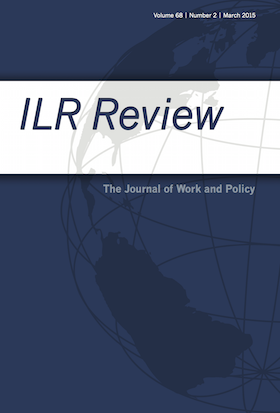
Measuring Job Creation, Growth, and Survival among the Universe of Start-ups in the United States Using a Combined Start-up Panel Data Set
in: ILR Review, Nr. 5, 2019
Abstract
The field of entrepreneurship is growing rapidly and expanding into new areas. This article presents a new compilation of administrative panel data on the universe of business start-ups in the United States, which will be useful for future research in entrepreneurship. To create the US start-up panel data set, the authors link the universe of non-employer firms to the universe of employer firms in the Longitudinal Business Database (LBD). Start-up cohorts of more than five million new businesses per year, which create roughly three million jobs, can be tracked over time. To illustrate the potential of the new start-up panel data set for future research, the authors provide descriptive statistics for a few examples of research topics using a representative start-up cohort.
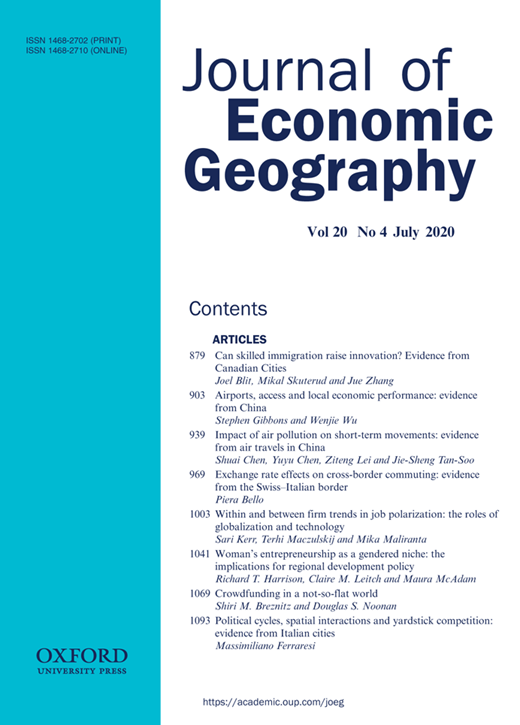
Taken by Storm: Business Financing and Survival in the Aftermath of Hurricane Katrina
in: Journal of Economic Geography, Nr. 6, 2018
Abstract
We use Hurricane Katrina’s damage to the Mississippi coast in 2005 as a natural experiment to study business survival in the aftermath of a capital-destruction shock. We find very low survival rates for businesses that incurred physical damage, particularly for small firms and less-productive establishments. Conditional on survival, larger and more-productive businesses that rebuilt their operations hired more workers than their smaller and less-productive counterparts. Auxiliary evidence from the Survey of Business Owners suggests that the differential size effect is tied to the presence of financial constraints, pointing to a socially inefficient level of exits and to distortions of allocative efficiency in response to this negative shock. Over time, the size advantage disappeared and market mechanisms seem to prevail.

Business Dynamics of Innovating Firms: Linking U.S. Patents with Administrative Data on Workers and Firms
in: Journal of Economics and Management Strategy, Nr. 3, 2018
Abstract
This paper discusses the construction of a new longitudinal database tracking inventors and patent-owning firms over time. We match granted patents between 2000 and 2011 to administrative databases of firms and workers housed at the U.S. Census Bureau. We use inventor information in addition to the patent assignee firm name to improve on previous efforts linking patents to firms. The triangulated database allows us to maximize match rates and provide validation for a large fraction of matches. In this paper, we describe the construction of the database and explore basic features of the data. We find patenting firms, particularly young patenting firms, disproportionally contribute jobs to the U.S. economy. We find that patenting is a relatively rare event among small firms but that most patenting firms are nevertheless small, and that patenting is not as rare an event for the youngest firms compared to the oldest firms. Although manufacturing firms are more likely to patent than firms in other sectors, we find that most patenting firms are in the services and wholesale sectors. These new data are a product of collaboration within the U.S. Department of Commerce, between the U.S. Census Bureau and the U.S. Patent and Trademark Office.
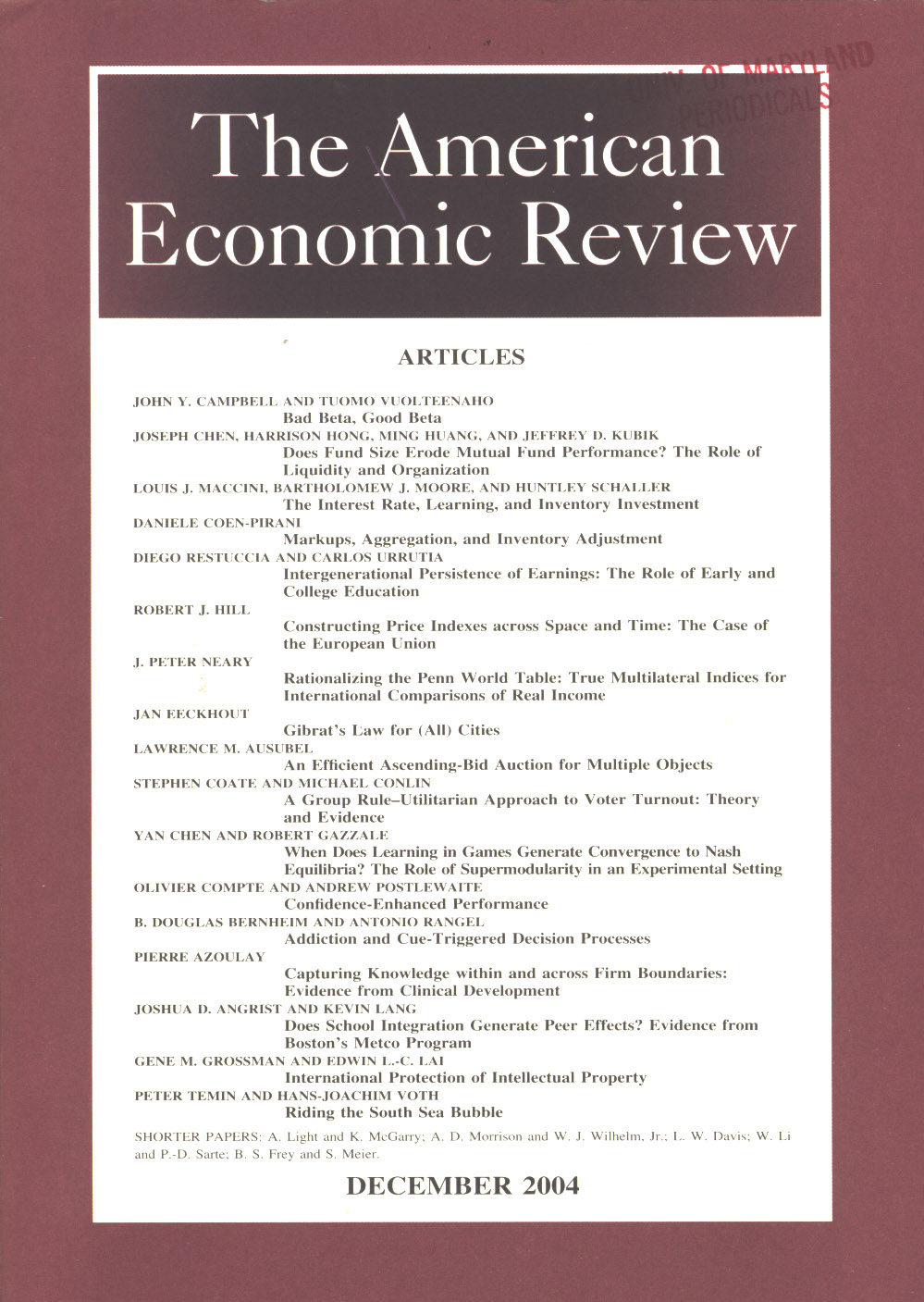
Declining Dynamism, Allocative Efficiency, and the Productivity Slowdown
in: American Economic Review: Papers and Proceedings, Nr. 5, 2017
Abstract
A large literature documents declining measures of business dynamism including high-growth young firm activity and job reallocation. A distinct literature describes a slowdown in the pace of aggregate labor productivity growth. We relate these patterns by studying changes in productivity growth from the late 1990s to the mid 2000s using firm-level data. We find that diminished allocative efficiency gains can account for the productivity slowdown in a manner that interacts with the within-firm productivity growth distribution. The evidence suggests that the decline in dynamism is reason for concern and sheds light on debates about the causes of slowing productivity growth.

Taking the Leap: The Determinants of Entrepreneurs Hiring Their First Employee
in: Journal of Economics and Management Strategy, Nr. 1, 2017
Abstract
Job creation is one of the most important aspects of entrepreneurship, but we know relatively little about the hiring patterns and decisions of start‐ups. Longitudinal data from the Integrated Longitudinal Business Database (iLBD), Kauffman Firm Survey (KFS), and the Growing America through Entrepreneurship (GATE) experiment are used to provide some of the first evidence in the literature on the determinants of taking the leap from a nonemployer to employer firm among start‐ups. Several interesting patterns emerge regarding the dynamics of nonemployer start‐ups hiring their first employee. Hiring rates among the universe of nonemployer start‐ups are very low, but increase when the population of nonemployers is focused on more growth‐oriented businesses such as incorporated and employer identification number businesses. If nonemployer start‐ups hire, the bulk of hiring occurs in the first few years of existence. After this point in time, relatively few nonemployer start‐ups hire an employee. Focusing on more growth‐ and employment‐oriented start‐ups in the KFS, we find that Asian‐owned and Hispanic‐owned start‐ups have higher rates of hiring their first employee than white‐owned start‐ups. Female‐owned start‐ups are roughly 10 percentage points less likely to hire their first employee by the first, second, and seventh years after start‐up. The education level of the owner, however, is not found to be associated with the probability of hiring an employee. Among business characteristics, we find evidence that business assets and intellectual property are associated with hiring the first employee. Using data from the largest random experiment providing entrepreneurship training in the United States ever conducted, we do not find evidence that entrepreneurship training increases the likelihood that nonemployers hire their first employee.
Arbeitspapiere

Credit Card Entrepreneurs
in: IWH Discussion Papers, Nr. 5, 2025
Abstract
<p>Utilizing near real-time QuickBooks data from over 1.6 million small businesses and a targeted survey, this paper highlights the critical role credit card financing plays for small business activity. We examine a two year period beginning in January of 2021. A turbulent period during which, credit card usage by small U.S. businesses nearly doubled, interest payments rose by 60%, and delinquencies reached 2.8%. We find, first, monthly credit card payments were up to three times higher than loan payments during this time. Second, we use targeted surveys of these small businesses to establish credit cards as a key financing source in response to firm-level shocks, such as uncertain cash flows and overdue invoices. Third, we establish the importance of credit cards as an important financial transmission mechanism. Following the Federal Reserve’s rate hikes in early 2022, banks cut credit card supply, leading to a 15.75% drop in balances and a 10% decline in revenue growth, as well as a 1.5% decrease in employment growth among U.S. small businesses. These higher rates also rendered interest payments unsustainable for many, contributing to half of the observed increase in delinquencies. Lastly, a simple heterogeneous firm model with a cash-in-hand constraint illustrates the significant macroeconomic impact of credit card financing on small business activity.</p>

Reassessing EU Comparative Advantage: The Role of Technology
in: IWH Discussion Papers, Nr. 26, 2024
Abstract
<p>Based on the sufficient statistics approach developed by Huang and Ottaviano (2024), we show how the state of technology of European industries relative to the rest of the world can be empirically assessed in a way that is simple in terms of computation, parsimonious in terms of data requirements, but still comprehensive in terms of information. The lack of systematic cross-industry correlation between export specialization and technological advantage suggests that standard measures of revealed comparative advantage only imperfectly capture a country’s technological prowess due to the concurrent influences of factor prices, market size, markups, firm selection and market share reallocation.</p>
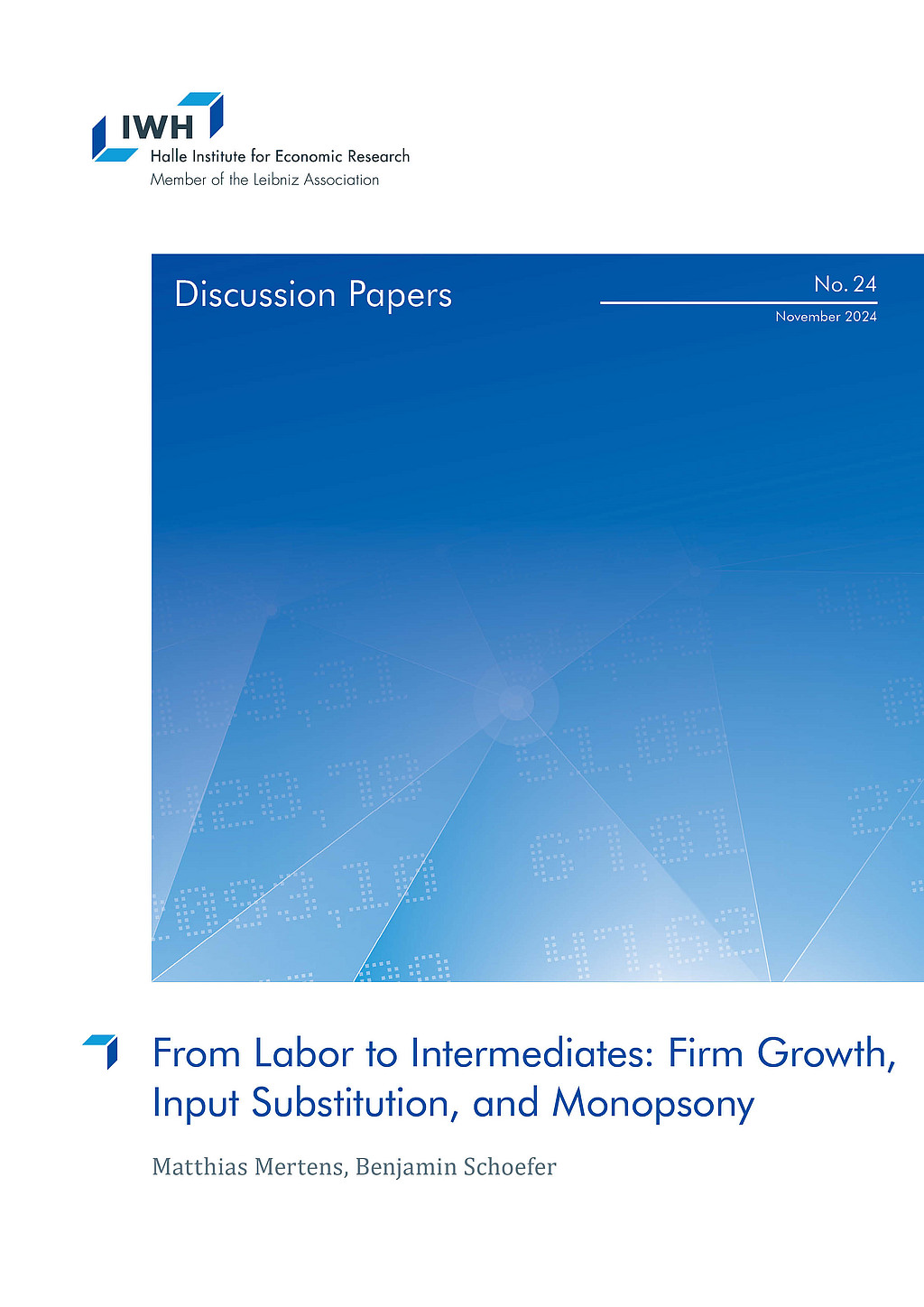
From Labor to Intermediates: Firm Growth, Input Substitution, and Monopsony
in: IWH Discussion Papers, Nr. 24, 2024
Abstract
<p>We document and dissect a new stylized fact about firm growth: the shift from labor to intermediate inputs. This shift occurs in input quantities, cost and output shares, and output elasticities. We establish this fact using German firm-level data and replicate it in administrative firm data from 11 additional countries. We also document these patterns in micro-aggregated industry data for 20 European countries (and, with respect to industry cost shares, for the US). We rationalize this novel regularity within a parsimonious model featuring (i) an elasticity of substitution between intermediates and labor that exceeds unity, and (ii) an increasing shadow price of labor relative to intermediates, due to monopsony power over labor or labor adjustment costs. The shift from labor to intermediates accounts for one half to one third of the decline in the labor share in growing firms (the remainder is due to wage markdowns and markups) and rationalizes most of the labor share decline in growing industries.</p>

Declining Job Reallocation in Europe: The Role of Shocks, Market Power, and Technology
in: IWH Discussion Papers, Nr. 19, 2023
Abstract
<p>We study changes in job reallocation in Europe after 2000 using novel microaggregated data that we collected for 19 European countries. In all countries, we document broad-based declines in job reallocation rates that concern most economic sectors and size classes. These declines are mainly driven by dynamics within sectors, size, and age classes rather than by compositional changes. Simultaneously, employment shares of young firms decline. Consistent with US evidence, firms’ employment has become less responsive to productivity shocks. However, the dispersion of firms’ productivity shocks has decreased too. To enhance our understanding of these patterns, we derive and apply a firm-level framework that relates changes in firms’ market power, labor market imperfections, and production technology to firms’ responsiveness and job reallocation. Using German firm-level data, we find that changes in markups and labor output elasticities, rather than adjustment costs, are key in rationalizing declining responsiveness.</p>
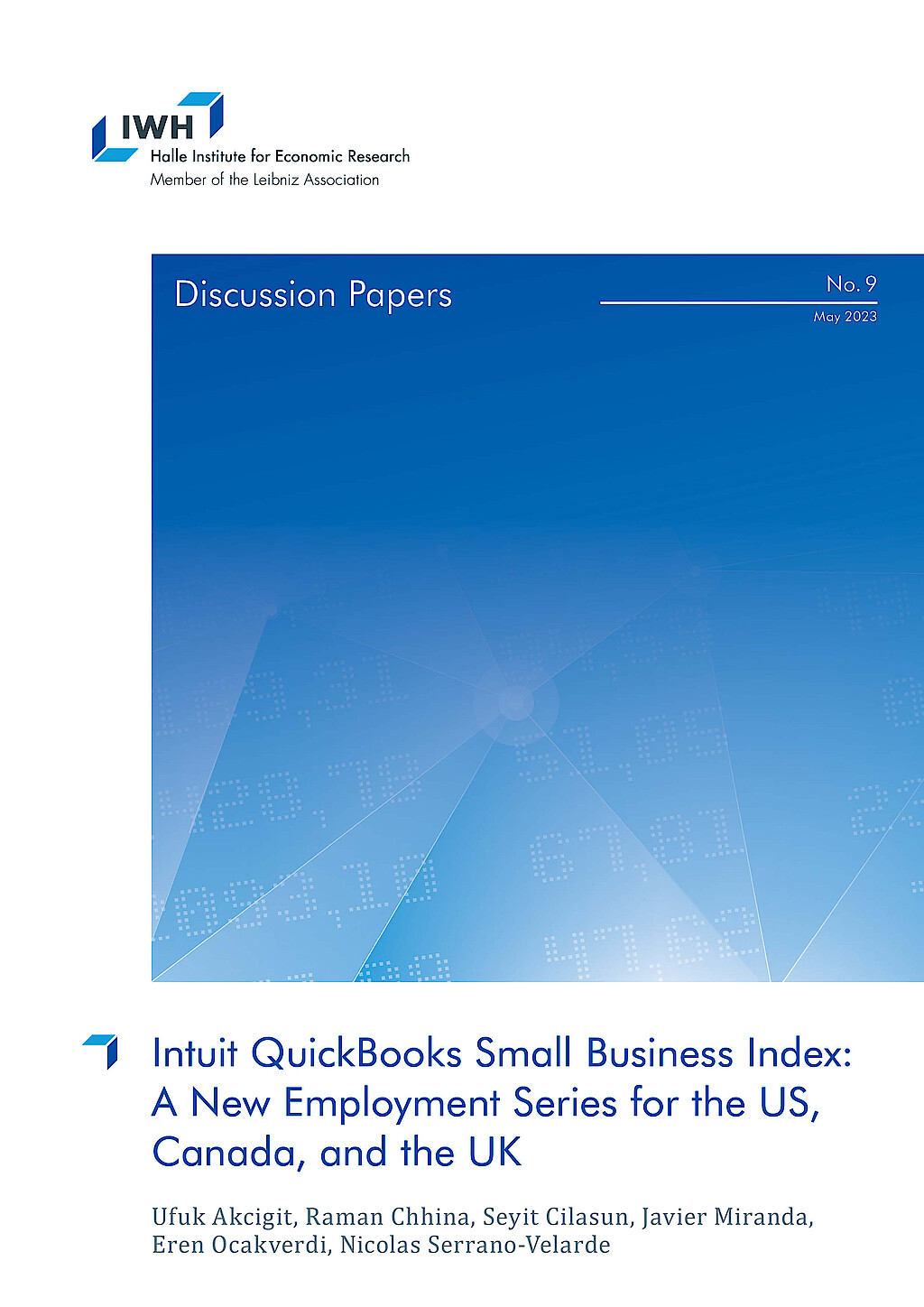
Intuit QuickBooks Small Business Index: A New Employment Series for the US, Canada, and the UK
in: IWH Discussion Papers, Nr. 9, 2023
Abstract
Small and young businesses are essential for job creation, innovation, and economic growth. Even most of the superstar firms start their business life small and then grow over time. Small firms have less internal resources, which makes them more fragile and sensitive to macroeconomic conditions. This suggests the need for frequent and real-time monitoring of the small business sector’s health. Previously this was difficult due to a lack of appropriate data. This paper fills this important gap by developing a new Intuit QuickBooks Small Business Index that focuses on the smallest of small businesses with at most 9 workers in the US and the UK and at most 19 workers in Canada. The Index aggregates a sample of anonymous Quick- Books Online Payroll subscriber data (QBO Payroll sample) from 333,000 businesses in the US, 66,000 in Canada, and 25,000 in the UK. After comparing the QBO Payroll sample data to the official statistics, we remove the seasonal components and use a Flexible Least Squares method to calibrate the QBO Payroll sample data against official statistics. Finally, we use the estimated model and the QBO Payroll sample data to generate a near real-time index of economic activity. We show that the estimated model performs well both in-sample and out-of-sample. Additionally, we use this analysis for different regions and industries. Keywords:













